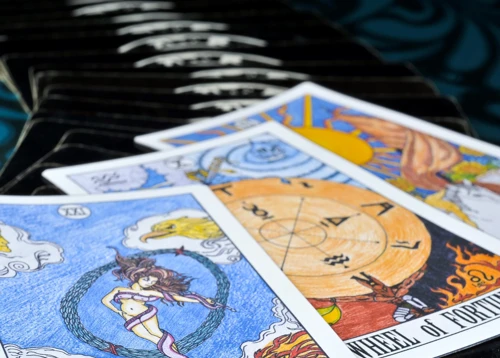Tarot cards have long been used as tools for divination and gaining insights into various aspects of life, including love and relationships. Whether you’re new to the world of tarot or an experienced practitioner, understanding the role of reversed tarot cards can add a new dimension to your readings. In this article, we will delve into the intriguing realm of reversed tarot cards and explore their significance in unveiling love patterns. From interpreting specific reversed cards to integrating them into spread layouts, we will provide you with step-by-step guidance on using reversed tarot cards to enhance your love readings. So, grab your deck and get ready to discover the hidden messages behind reversed tarot cards in the realm of love.
Contents
- The Basics of Tarot
- Interpreting Reversed Tarot Cards
- Unveiling Love Patterns
- Interpreting Specific Reversed Tarot Cards
- Integrating Reversed Cards into Love Readings
- Enhancing Your Love Readings with Reversed Tarot Cards
- Conclusion
-
Frequently Asked Questions
- 1. How accurate are tarot card readings for love and relationships?
- 2. What does it mean when a tarot card appears reversed?
- 3. Can love patterns be revealed through reversed tarot cards?
- 4. How can I incorporate reversed tarot cards into my love readings?
- 5. Can reversed cards change the overall outcome of a love reading?
- 6. Should I be concerned if I receive multiple reversed cards in a love reading?
- 7. Are reversed tarot cards always negative?
- 8. Can reversed tarot cards predict the future of a romantic relationship?
- 9. Should I always include reversed cards in my love readings?
- 10. What’s the role of intuition when interpreting reversed tarot cards in love readings?
- References
The Basics of Tarot
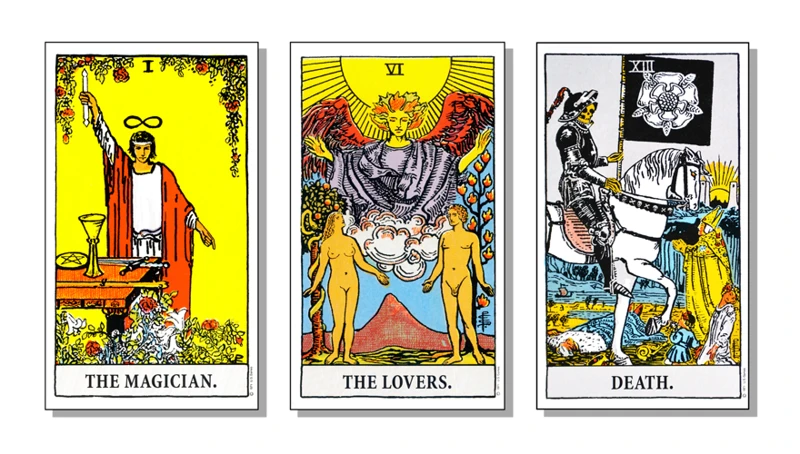
Tarot cards have a rich and fascinating history, serving as powerful tools for divination and self-reflection. These mystical cards are believed to have originated in 15th century Europe, evolving over time to encompass a deck of 78 cards, each with its own symbolism and meaning. The deck is divided into major arcana and minor arcana cards, each playing a unique role in tarot readings. Major arcana cards represent significant life events and spiritual lessons, while minor arcana cards delve into everyday aspects of life, including love and relationships. The four suits of the minor arcana – cups, pentacles, swords, and wands – correspond to different elements and aspects of human existence. Understanding the key elements of tarot and its historical significance lays a solid foundation for exploring the intricacies of reversed tarot cards, their impact on love readings, and the broader patterns they unveil in relationships. To grasp the basics of tarot, let’s dive into its intriguing history and the fundamental elements that shape its wisdom and guidance. [Link: /common-reversed-tarot-meaning-love/]
1.1 Brief History of Tarot
The history of tarot is shrouded in mystery and intrigue. While its exact origins remain uncertain, tarot cards are believed to have emerged in medieval Europe during the 15th century. Initially, the tarot deck consisted of playing cards used for games rather than divination. It wasn’t until the late 18th century that French occultist Jean-Baptiste Alliette, also known as Etteilla, popularized tarot as a tool for divination and self-reflection. His influential work, “Book of Thoth,” laid the foundation for modern tarot interpretations. The tarot deck evolved over time, with the introduction of the Rider-Waite-Smith deck in the early 20th century, which became the standard for tarot readers worldwide. This iconic deck, with its intricate symbolism and vivid imagery, revolutionized the way tarot was perceived and interpreted. Today, tarot is widely embraced as a powerful tool for gaining insights into various aspects of life, including love and relationships. Understanding the brief history of tarot helps us appreciate its rich tradition and the mystical journey it has taken to become an enduring source of guidance and wisdom. [Link: /reversed-tarot-cards-love-readings/]
1.2 Key Elements of Tarot
Tarot cards derive their power and significance from various key elements that shape their interpretation and guidance. These elements include the major arcana, minor arcana, suits, numbers, and symbolism.
1. The major arcana consists of 22 cards that represent major life events, archetypal energies, and spiritual lessons. Each card carries its own unique symbolism and meaning, contributing to the overall narrative of a tarot reading.
2. The minor arcana, comprising 56 cards, delves into the everyday aspects of life. Divided into four suits – cups, pentacles, swords, and wands – the minor arcana reflects the emotional, material, intellectual, and creative aspects of human existence.
3. The suits represent different elements and aspects of life. Cups symbolize emotions, relationships, and the realm of the heart. Pentacles embody material abundance, work, and physicality. Swords signify thoughts, challenges, and conflicts. Wands represent creativity, passion, and inspiration.
4. Numbers play a crucial role in tarot, as they provide additional insights into the cards’ meanings and interpretations. Each number carries its own energetic vibration, influencing the overall message of the card it appears on.
5. Symbolism in tarot cards adds depth and layers of meaning to the reading. Every image, color, and symbol depicted holds significance and conveys hidden messages that require intuitive interpretation.
Understanding these key elements of tarot allows readers to unlock the intricate messages and guidance offered by the cards. As we explore the role of reversed tarot cards, it is important to keep these elements in mind, as they will enhance our understanding of the impact of reversed cards on love readings and relationships. [Link: /reversed-tarot-cards-relationship-impact/]
Interpreting Reversed Tarot Cards
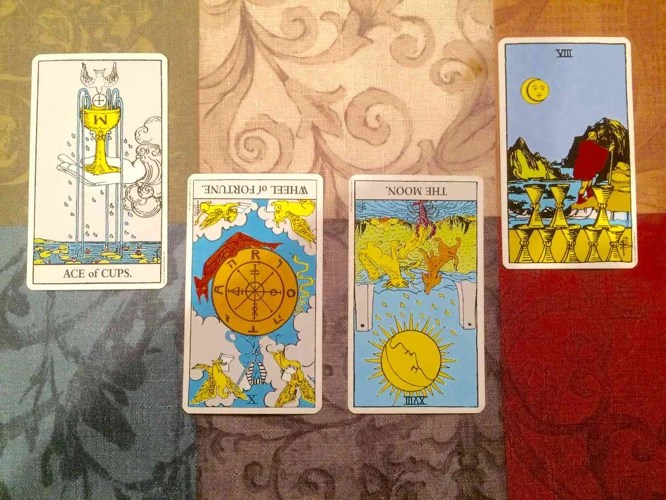
In the realm of tarot, reversed cards hold a special significance and offer a deeper layer of interpretation. When a card appears upside down or in reverse during a reading, it symbolizes a unique energy or a challenge to the traditional meaning of the card. Interpreting reversed tarot cards can provide valuable insights into the complexities of a situation, revealing hidden obstacles, subconscious influences, or untapped potentials. Understanding reversed tarot cards requires a nuanced approach that takes into account the overall theme of the reading, the surrounding cards, and the individual card’s symbolism. While some practitioners view reversed cards as negative omens, others see them as prompts for growth and self-reflection. By exploring the various approaches to interpreting reversed tarot cards, you can unlock a wealth of additional information in your readings and gain a deeper understanding of the messages the cards are trying to convey. [Link: /reversed-tarot-cards-love-readings/]
2.1 Understanding Reversed Tarot Cards
Reversed tarot cards, also known as inverted cards, hold a special place in the world of tarot readings. When a card is drawn in a reading and appears upside down, it is considered a reversed card. However, understanding the meaning and significance of reversed tarot cards is not as straightforward as their upright counterparts. Reversed cards add a layer of complexity and nuance to a reading, often conveying a different energy or message compared to their upright counterparts. While upright cards generally represent positive or balanced energies, reversed cards can suggest blockages, delays, or challenges in the area of life that the card represents. They can signify a need for inner reflection, a shift in perspective, or unresolved issues that need attention. Interpreting reversed tarot cards requires a keen eye for symbolism and intuition, as the meaning of a reversed card can vary depending on the specific card, the surrounding cards, and the context of the reading. It’s important to avoid jumping to conclusions or interpreting reversed cards in a purely negative light; they offer valuable insights into areas that may require growth, healing, or transformation. By delving deeper into the symbolism and messages of reversed tarot cards, readers can unlock a wealth of knowledge and understanding in their readings.
2.2 Different Approaches to Reversed Cards
When it comes to interpreting reversed tarot cards, there are various approaches that readers can take. These different approaches provide valuable insights into the meaning and significance of reversed cards in a reading. Here are three common approaches to consider:
1. Opposite Meaning: One approach is to interpret the reversed card as the opposite of its upright meaning. For example, if an upright card represents abundance, the reversed card could signify a lack or scarcity. This approach can highlight challenges or obstacles that need to be overcome in a particular situation.
2. Blocked Energy: Another approach is to view a reversed card as an indication of blocked or stagnant energy. In this interpretation, the reversed card suggests that there may be obstacles or resistance preventing the energy of the card from flowing freely. It encourages the reader to explore ways to remove these blocks and restore balance and harmony.
3. Inner Reflection: A third approach is to see reversed cards as an invitation for inner reflection and introspection. Reversed cards can indicate that the energies or qualities associated with the card need to be more fully embraced or understood on a deeper level. They encourage the reader to explore their own inner landscape and gain a deeper understanding of themselves or the situation at hand.
It’s important to note that each reader may have their own unique approach to interpreting reversed cards, and there isn’t a one-size-fits-all method. Some readers may combine these approaches or develop their own personalized interpretations based on their experience and intuition. The key is to have an open mind, trust your intuition, and let the cards guide you in your exploration of reversed tarot cards.
Unveiling Love Patterns
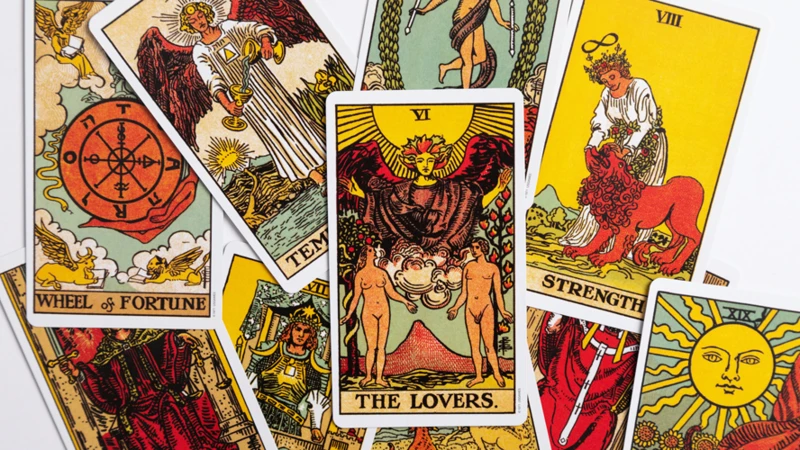
Love and relationships hold a special place in the realm of tarot, offering valuable insights into the dynamics and patterns that shape our romantic lives. When it comes to love readings, reversed tarot cards possess a unique significance. These cards, when drawn in their reversed position, can indicate hidden emotions, obstacles, or potential challenges within a relationship. By unraveling the messages embedded in reversed tarot cards, we can gain a deeper understanding of love patterns and dynamics that may otherwise go unnoticed. Whether it’s the reversed Lovers card symbolizing a lack of harmony, the reversed Two of Cups suggesting communication issues, or the reversed Ten of Cups representing unfulfilled emotional needs, each reversed card holds its own story to tell. By uncovering these patterns, we can empower ourselves to make more informed decisions, foster healthier relationships, and navigate the intricate realm of love with greater clarity and awareness.
3.1 Love and Relationships in Tarot
When it comes to love and relationships, tarot can be a powerful tool for gaining insights and guidance. Each tarot card carries its own unique symbolism and meaning, which can be applied to matters of the heart. In tarot, the suit of Cups is often associated with emotions, love, and relationships. The cards in this suit represent the various aspects of romantic connections, from the initial spark of attraction to the deep emotional bonds that form over time. The major arcana cards also have significant implications for love readings, as they delve into the soul’s journey and the profound connections we form with others. For example, The Lovers card represents love, harmony, and partnerships, while The Two of Cups symbolizes mutual attraction and emotional connection. Exploring the cards within the context of love and relationships can provide valuable insights into the dynamics, challenges, and potential outcomes in matters of the heart. Whether you’re seeking advice on a current relationship, hoping to attract new love, or looking for guidance on healing and self-love, the tarot offers a rich tapestry of archetypes and symbols to explore in the realm of love. So, let’s dive deeper into the world of tarot and uncover the significance of reversed cards specifically in love readings.
3.2 The Significance of Reversed Cards in Love Readings
In love readings, reversed tarot cards hold a significant and nuanced meaning that can shed light on the complexities of relationships and emotional dynamics. When a card appears upside-down or reversed, its energy is considered to be in a state of obstruction or imbalance. This can indicate obstacles, challenges, or unresolved issues within a romantic connection. Reversed cards offer a deeper level of insight by highlighting hidden emotions, subconscious patterns, and unacknowledged feelings. They prompt us to examine the shadow aspects of a relationship and explore areas of growth or healing. Each reversed card carries its own unique interpretation, amplifying or diminishing the energy of its upright counterpart. For example, the reversed Three of Cups may suggest a lack of harmony or unfulfilled emotional needs within a social or romantic circle, while the reversed Ace of Cups could indicate difficulties in emotional expression or a need for self-love before fully committing to a relationship. It is essential to approach reversed cards with an open mind and intuitive sensitivity, incorporating them into your love readings to gain a comprehensive and holistic understanding of the dynamics at play.
3.3 Common Love Patterns Revealed by Reversed Tarot Cards
When it comes to love readings, reversed tarot cards can offer valuable insights into common patterns and dynamics within relationships. Reversed cards often indicate a shift or a blockage in energy, suggesting that there may be challenges or unresolved issues in the romantic sphere. One common love pattern revealed by reversed tarot cards is the theme of emotional turmoil. For instance, the Eight of Cups reversed may signify someone who is continuously searching for love and fulfillment but struggles to find satisfaction in their relationships. This pattern often points to a need for inner healing and self-reflection before entering into a new partnership. Another love pattern that can be revealed through reversed tarot cards is a lack of trust or communication. The reversed Seven of Swords may indicate deception or hidden agendas within a relationship, urging individuals to address and confront these issues in order to rebuild trust. Additionally, the reversed Nine of Pentacles may suggest financial conflicts or dependency within a partnership, prompting individuals to reassess their values and work towards a healthier balance. These common love patterns serve as guidance for individuals seeking clarity and understanding in their romantic lives. By recognizing these patterns, individuals can take proactive steps towards personal growth and cultivating healthier, more fulfilling relationships.
Interpreting Specific Reversed Tarot Cards
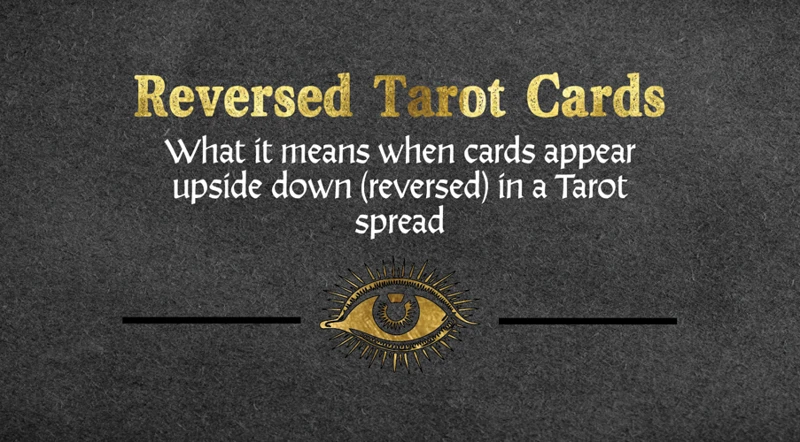
As you explore the fascinating realm of reversed tarot cards, it is essential to delve into the interpretations of specific cards and their significance in love readings. One powerful card to consider is the Reversed Lovers Card. When this card appears upside down, it often signifies conflicts, choices, or difficulties in relationships. It may suggest a lack of harmony or emotional disconnection. Another card that holds important insights is the Reversed Two of Cups. In its reversed position, this card can indicate imbalance, disagreements, or a loss of emotional connection between partners. Lastly, the Reversed Ten of Cups highlights issues related to emotional fulfillment and domestic harmony. It might suggest discord or challenges within a family dynamic. Each of these reversed cards provides clues into potential stumbling blocks or areas of growth within a romantic relationship. By carefully interpreting these specific cards, you can gain deeper insights into the nuances and complexities of love readings.
4.1 The Reversed Lovers Card
The Lovers card in tarot is often associated with love, relationships, and partnership. When this card appears in a reversed position, its meaning takes on a different tone. The Reversed Lovers card suggests disharmony, conflict, and a lack of connection in romantic relationships. It may indicate a strained relationship, a breakup, or a decision to walk away from a partnership that is no longer serving one’s highest good. This card can also signify a period of self-reflection and introspection, prompting individuals to question their values, desires, and needs in relationships. It encourages a deeper examination of one’s emotional attachments and the impact they have on personal growth. In love readings, the Reversed Lovers card serves as a reminder to reassess the dynamics within a relationship and consider whether it aligns with one’s authentic self. It urges individuals to act in alignment with their own well-being and make choices that will bring about a greater sense of balance and harmony.
4.2 The Reversed Two of Cups
When the Two of Cups appears reversed in a tarot reading, it suggests a disruption in harmony and balance within a romantic relationship or partnership. This card typically symbolizes the initial stages of a deep emotional connection, mutual understanding, and reciprocity. However, in its reversed position, it indicates a potential lack of emotional fulfillment or imbalance in the relationship. It may signify a period of conflict, misunderstandings, or unmet expectations between partners. Communication breakdowns and unresolved issues may be prevalent, causing distance and dissatisfaction.
In the realm of love readings, the reversed Two of Cups can signify unrequited love or a lack of emotional reciprocity. It may indicate that one partner is more emotionally invested in the relationship than the other, leading to feelings of resentment or imbalance. It is essential to address these issues honestly and openly to restore the harmony and connection within the relationship.
When interpreting the reversed Two of Cups, it is crucial to consider the surrounding cards in the spread. The presence of cards such as the Five of Cups or the Ten of Swords may indicate deeper emotional wounds or the end of a partnership. On the other hand, cards like the Eight of Cups or the Temperance reversed may suggest a need for introspection and finding inner balance before seeking harmony with a partner.
The reversed Two of Cups serves as a reminder to pay attention to the emotional dynamics within a relationship. It urges individuals to address any imbalances, communicate honestly, and work towards restoring harmony and connection with their partners. By acknowledging and resolving conflicts, individuals can lay the groundwork for a more fulfilling and nurturing relationship.
4.3 The Reversed Ten of Cups
The Reversed Ten of Cups is a card that may indicate disharmony or discontentment in the realm of emotions and relationships. When this card appears in a reading, it suggests that there may be underlying issues within a relationship or family dynamics that need to be addressed. It can symbolize tension, disagreements, or unfulfilled expectations. In a love reading, the reversed Ten of Cups may signify a lack of emotional fulfillment or a temporary setback in a romantic partnership. It could indicate unresolved conflicts, miscommunication, or a loss of connection between partners. It’s essential to examine the individual cards surrounding the reversed Ten of Cups to gain a deeper understanding of the specific challenges or obstacles that are affecting the harmony within the relationship. Additionally, this card may also serve as a reminder to prioritize open communication, compromise, and understanding in order to restore balance and create a more harmonious and fulfilling emotional connection.
Integrating Reversed Cards into Love Readings
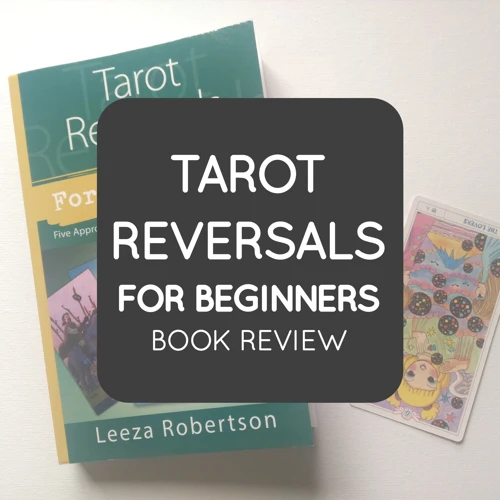
When it comes to love readings, integrating reversed tarot cards adds depth and nuance to the interpretation process. Reversed cards, also known as upside-down cards, provide a shifted perspective on love and relationships. When a card appears in reverse, its traditional meaning is often altered, signaling a potential blockage, delay, or internal conflict within the realm of love. To seamlessly integrate reversed cards into love readings, it’s essential to consider their unique symbolism and their relationship with the surrounding cards. By paying attention to the energy and narrative of the spread, you can uncover hidden emotions, unresolved issues, or unexpressed desires that may be influencing the dynamics of a relationship. Remember that reversed cards should not be viewed as solely negative or problematic but rather as opportunities for growth, self-awareness, and transformation within love connections. By embracing reversed cards and incorporating them into your readings, you can provide a more comprehensive and insightful exploration of love and relationships.
5.1 Considering Reversed Cards in Spread Layouts
When it comes to conducting tarot readings, the layout of the cards, also known as a spread, plays a crucial role in the interpretation process. In the context of love readings, considering reversed cards in spread layouts can provide valuable insights into the dynamics of relationships and romantic outcomes. Here are some key points to keep in mind:
1. Single-card spread: In this simple yet powerful spread, each card represents a specific aspect of love or relationship. When a card appears in reverse, it suggests challenges or obstacles in that area. For instance, a reversed Three of Cups may indicate a lack of harmony or potential conflicts among friends or loved ones.
2. Three-card spread: This spread provides a snapshot of the past, present, and future of a love situation. When interpreting reversed cards in this layout, pay attention to the flow and progression of energy. Reversed cards in the past position may suggest unresolved issues or past traumas affecting current relationships.
3. Celtic Cross spread: This complex spread offers a comprehensive analysis of a love situation. Each position represents different aspects of the relationship, such as desires, challenges, and potential outcomes. When reversed cards appear, they can indicate hidden factors, internal conflicts, or unwanted influences affecting the relationship.
4. Elemental spread: This unique spread incorporates the four elements (fire, water, air, and earth) to gain a holistic understanding of a love situation. Reversed cards in each elemental position can provide insights into the corresponding aspect of the relationship. For example, a reversed Queen of Swords in the air position may suggest communication issues or misunderstandings.
Remember, the interpretation of reversed cards in spread layouts should always be done in conjunction with the surrounding cards and your intuition. It’s important to view the reversed cards as opportunities for growth, lessons to be learned, or potential challenges to be overcome. By carefully considering reversed cards within spread layouts, you can unlock deeper levels of insight into the complex tapestry of love and relationships.
5.2 Combining Reversed and Upright Cards
When it comes to love readings, combining reversed and upright cards can provide a more nuanced and comprehensive understanding of the situation at hand. The interaction between reversed and upright cards adds depth and complexity to the reading, offering insights into the various aspects of a relationship.
To effectively interpret a combination of reversed and upright cards, it’s important to consider both their individual meanings as well as their interactions within the spread. Start by examining the upright cards and their indications towards the overall theme or energy surrounding the relationship. These cards represent the external influences, strengths, and positive aspects of the situation. Pay close attention to their symbolism and messages.
Next, focus on the reversed cards and their significance within the context of the spread. Reversed cards often highlight challenges, obstacles, or unresolved issues within the relationship. They can shed light on hidden or repressed emotions, communication issues, or areas of disharmony. Take note of the reversed cards’ unique interpretations and relate them back to the specific area of the relationship they represent.
Consider the relationship between the reversed and upright cards within the spread. Do they present contrasting energies or themes? Are there reversed cards that directly oppose or challenge the messages of the upright cards? Alternatively, do they complement and enhance each other’s meanings? The dynamic between the reversed and upright cards will offer valuable insights into the complexities of the relationship.
Lastly, trust your intuition and let your instinct guide the interpretation. The combination of reversed and upright cards brings depth and subtlety to the reading, and it is essential to trust your inner voice and personal connection to the cards. Allow yourself to tap into your intuitive wisdom and unravel the layers of meaning within the spread.
By combining reversed and upright cards, you can uncover a more holistic understanding of the relationship, embracing both its strengths and challenges. This approach allows for a richer and more insightful love reading, providing guidance and clarity for those seeking answers and guidance in matters of the heart.
Enhancing Your Love Readings with Reversed Tarot Cards
When it comes to love readings, integrating reversed tarot cards into your practice can provide a deeper level of insight and understanding. There are several methods you can employ to enhance your love readings using reversed cards. First, consider incorporating reversed cards into your spread layouts. This can be done by assigning specific positions in the spread to represent reversed cards, allowing you to examine the unique energy they bring to the reading. Additionally, combining reversed and upright cards can give you a more balanced perspective on a relationship or situation, offering a nuanced understanding of both the challenges and potential positive outcomes. To ensure an accurate interpretation, it is essential to trust your intuition and rely on your knowledge of the tarot’s symbolism and meanings. Reflecting on past readings where reversed cards played a significant role can also provide valuable insights and help you refine your approach. By utilizing these techniques and embracing the wisdom of reversed tarot cards, you can elevate your love readings to new heights of accuracy and depth.
6.1 Tips for Accurate Interpretation
When it comes to interpreting reversed tarot cards in love readings, accuracy is of utmost importance. To ensure your interpretations are as precise as possible, consider the following tips:
1. Dive deep into symbolism: Reversed cards often offer subtle nuances and alternate meanings compared to their upright counterparts. Take the time to explore the symbolism of each card and how it relates to love and relationships. Consider the colors, imagery, and emotions evoked by the card to uncover hidden messages.
2. Pay attention to surrounding cards: Context is key in tarot readings. Analyzing the cards that surround the reversed card can help provide further insights. Look for patterns, connections, or contrasting elements between the cards to better understand the overall message being conveyed.
3. Trust your intuition: While it’s essential to rely on your knowledge of tarot, don’t underestimate the power of your intuition. Sometimes, your gut feelings and instincts can offer valuable guidance when interpreting reversed cards. Allow your intuition to guide you and be open to the messages that come through.
4. Consider the querent’s energy: The energy and intentions of the person for whom you are conducting the reading can influence the meaning of the reversed cards. Take a moment to connect with their energy before interpreting the cards, as it can provide valuable insights and tailor the reading to their specific circumstances.
5. Keep a tarot journal: Maintaining a tarot journal can be immensely helpful in improving your interpretation skills. Record your observations, experiences, and the outcomes of your readings. Over time, you’ll start to notice patterns and develop a deeper understanding of reversed cards in the context of love readings.
By incorporating these tips into your tarot practice, you’ll be better equipped to accurately interpret the messages conveyed by reversed tarot cards in love readings. Remember to approach each reading with an open mind and a commitment to providing meaningful insights to those seeking guidance.
6.2 Trusting Your Intuition
Trusting your intuition is essential when working with reversed tarot cards in love readings. Intuition is your inner voice, guiding you towards deeper insights and understanding. When interpreting reversed tarot cards, your intuition can play a significant role in deciphering their meaning within the context of the reading. Trusting your intuition means embracing your gut feelings, instincts, and inner wisdom without doubting or questioning their validity. When you encounter a reversed card, take a moment to tune into your intuition and let it guide your interpretation. Pay attention to any immediate thoughts, emotions, or sensations that arise when you see a reversed card. Trust that these subtle cues are valuable signals from your higher self or the divine, providing you with unique insights into the situation at hand. If a reversed card feels significant or resonates strongly with you, trust that feeling and explore its implications further. Sometimes, your intuition may challenge the traditional interpretations of a reversed card, and that’s okay. Remember that tarot is a deeply personal practice, and your intuition holds valuable wisdom that can enhance the accuracy and depth of your readings. So, trust your intuition, embrace its guidance, and allow it to lead you to deeper understanding and profound revelations when working with reversed tarot cards.
6.3 Reflecting on Past Readings
Reflecting on past readings is a valuable practice for any tarot reader, especially when it comes to love readings. By revisiting previous readings, you gain insights into your own interpretations, patterns, and growth as a reader. It allows you to analyze the accuracy of your past readings and refine your skills for future ones. Take the time to review the reversed tarot cards you encountered in love readings and examine the messages they conveyed. Consider the specific situations, emotions, or outcomes associated with those cards and evaluate how well your interpretations aligned with the actual events or experiences. Reflecting on past readings also helps you identify any biases or preconceived notions that may have influenced your interpretations. Were there any instances where you allowed personal beliefs or desires to color your readings? Recognizing these tendencies allows you to approach future readings with a clearer, more objective mindset. Additionally, reflecting on past readings can help you track recurring themes or patterns that emerge through reversed tarot cards. Perhaps you notice a consistent message or lesson that arises when certain cards appear in reverse. This awareness can deepen your understanding of love patterns and foster more accurate and insightful readings. So, make it a habit to regularly reflect on your past readings, celebrate your successes, learn from any misinterpretations, and continue to grow as a tarot reader. [Link: /reversed-tarot-cards-relationship-impact/]
Conclusion
In conclusion, the role of reversed tarot cards in love readings is an invaluable tool for gaining deeper insights into the complexities of relationships. By embracing the reversed cards and understanding their unique meanings, you can uncover hidden patterns and gain a more holistic understanding of love and its dynamics. Whether it’s the Reversed Lovers card indicating a need for self-love before entering a new relationship, or the Reversed Two of Cups suggesting a need to reevaluate a current partnership, reversed tarot cards offer a nuanced perspective on matters of the heart. Integrating reversed cards into your spread layouts and combining them with upright cards allows for a more comprehensive and accurate interpretation of the energies at play in a relationship. However, it’s crucial to trust your intuition and allow your personal connection to the cards to guide you. Remember to reflect on past readings, considering the accuracy of your interpretations and the lessons learned. As you continue to hone your tarot skills and explore the realm of reversed tarot cards, you’ll discover a wealth of wisdom that can enhance your love readings and provide guidance for navigating the intricacies of relationships. So, embrace the reversed cards and embark on a transformative journey of love and self-discovery through the mystical world of tarot.
Frequently Asked Questions
1. How accurate are tarot card readings for love and relationships?
Tarot card readings can offer valuable insights and guidance when it comes to love and relationships. However, it’s important to remember that the interpretation of the cards relies on the skills and intuition of the reader. The accuracy of the readings can vary depending on the reader’s experience and connection with the cards.
2. What does it mean when a tarot card appears reversed?
When a tarot card appears reversed, it indicates that the energy or message of the card is being blocked, delayed, or challenged in some way. Reversed cards often invite deeper introspection and highlight areas that may require attention or resolution.
3. Can love patterns be revealed through reversed tarot cards?
Absolutely! Reversed tarot cards can provide unique insights into love patterns and dynamics. They can shed light on hidden emotions, unresolved issues, patterns of behavior, and the overall energy surrounding love and relationships.
4. How can I incorporate reversed tarot cards into my love readings?
To incorporate reversed tarot cards into your love readings, start by familiarizing yourself with the meanings of each card when upright and reversed. Consider the context of the reading and the specific question or area of focus. Integrate the reversed cards into the spread, interpreting their messages in relation to the surrounding cards.
5. Can reversed cards change the overall outcome of a love reading?
Reversed cards can indeed alter the overall outcome or energy of a love reading. They provide additional layers of information and can reveal challenges, obstacles, or hidden aspects that may impact the outcome of a situation or relationship.
6. Should I be concerned if I receive multiple reversed cards in a love reading?
Receiving multiple reversed cards in a love reading does not necessarily indicate a negative outcome. It may suggest that there are complex dynamics at play or areas that require deeper exploration. However, it’s always important to trust your intuition and consider the overall energy of the reading.
7. Are reversed tarot cards always negative?
No, reversed tarot cards are not always negative. While they can indicate challenges or blocked energy, they can also offer opportunities for growth, self-reflection, and transformation. It’s essential to interpret the reversed cards within the broader context of the reading.
8. Can reversed tarot cards predict the future of a romantic relationship?
While tarot cards can provide insights and guidance, they are not meant to predict the future with absolute certainty. Tarot readings offer a snapshot of the present moment and the energy surrounding a situation. The future outcome of a romantic relationship depends on various factors and individual choices.
9. Should I always include reversed cards in my love readings?
Incorporating reversed cards into your love readings is a personal choice. Some readers prefer to work only with upright cards, while others find value in including reversed cards for a more comprehensive interpretation. Experiment and see what feels most comfortable and effective for you.
10. What’s the role of intuition when interpreting reversed tarot cards in love readings?
Intuition plays a crucial role in interpreting reversed tarot cards in love readings. While it’s important to have a solid understanding of the traditional meanings, trusting your intuition allows you to tap into the deeper layers of the cards and connect with the unique messages they hold for each situation.
